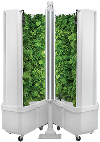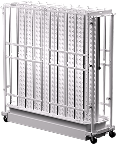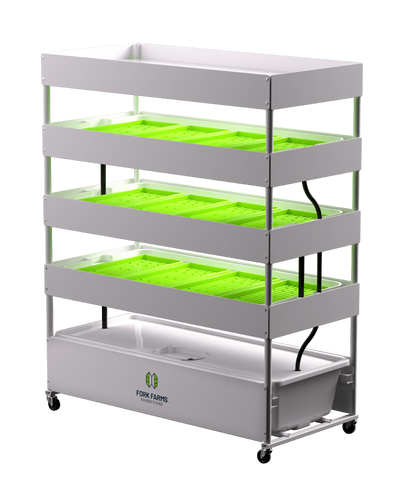The Biggest Trends in Hydroponics We've Seen This Year
Hydroponics dates back to 600 B.C., enabling ancient communities to grow plants and crops without using soil. Today, the hydroponics industry is thriving and plays a critical role in modern agriculture and the future of sustainability. Expected to surpass $45 billion by 2033, the hydroponics market is anticipated to expand at a 13.7% compound annual growth rate (CAGR). By 2023, the industry is predicted to be worth nearly $13 billion in 2023. The opportunity in this modern agricultural technique is why many within the food industry, education, and nonprofits are following trends in hydroponics and feel inspired to invest and innovate within the industry.
Understanding Hydroponics
Hydroponics enables the cultivation of plants without soil and is less resource-intensive than traditional agricultural methods or even alternative methods such as aeroponics Using controlled environment agriculture (CEA), farmers can plant in near-optimal conditions and effectively manage the six elements needed for plant growth, including light, air, water, nutrients, temperature, and space. As farmers have more control over nutrient content, pH, and growing environment, the consistent and effective use of hydroponics can lead to much higher crop yields and faster growth rates.
With many environmental and agricultural advantages, hydroponics enables farmers to get more from less resource allocation, reduce plant waste, and increase profits.,. As hydroponics systems utilize water, nutrients, and light to maintain healthy plant growth, they can also vary in size. Hydroponic growing systems can be as small as a tabletop unit or as large as a table or shelf. It's not a one-size-fits-all solution, with indoor hydroponics systems coming in multiple sizes.
Want to learn more about Hydroponics? Check out Hydroponics vs. Aeroponics, What's the Difference?
Trends in Hydroponics
The current trends in hydroponics and the thriving industry reflect the long-term, proven success of the technique.
Trend #1: Finding Creative Ways to Grow Without Soil
Soil can pose several complications for farmers, and challenges such as pests, diseases, and foodborne illnesses are all critical factors they must manage on a regular basis. Through chewing, eating, and laying eggs, soil-related insects may transmit disease agents, harming plants and posing a significant risk for farmers and consumers. Bacterial diseases, which can come from poor soil health, over and under-watering, and high humidity, are also difficult to manage in an uncontrolled environment. Vegetables like leafy greens can be susceptible to germs such as E. coli, Norovirus, Salmonella, Listeria, and Cyclospora, leading to product recalls and consumer illnesses.
Beyond possible harm to plants and illness, growing with soil can also result in economic loss for farmers. In 2023, the University of Exeter cited a significant profit loss from fungal infections in plants, with growers losing between 10 and 23 percent of their crops. With experts predicting this "perfect storm" of environmental factors, hydroponics provides a solution that can help farmers combat these predictions. Ultimately, when soil is not used in farming, there can be a significant reduction (if not elimination) of soil-related insects, fungi, bacteria, and foodborne illnesses.
That’s why many educators, companies, and organizations are implementing hydroponic systems. From DIY hydroponic systems to large-scale commercial systems, the latest technology and capabilities allow for creative innovation and exploration of farming without soil.
Trend #2: Expanding International Growth Potential
Hydroponics allows communities to grow indoors and year-round and can serve communities susceptible to challenging weather conditions such as drought and over-precipitation. Heavy rain, for instance, can erode and deplete soil and soil nutrients, harming the growth of vital crops. Regarding drought, hydroponics also addresses water scarcity concerns, using 90% less water than traditional agriculture. Incredibly humid environments, such as the Caribbean, can be difficult to grow in due to unpredictable and intense storm systems. On the other hand, colder climates, such as Alaska, don’t allow for a long growth season, minimizing the potential and profit from farming.
Trend #3: US to Remain at the Forefront of Hydroponic Innovation
The demand for locally sourced, fresh produce and the rising popularity of controlled environment agriculture (CEA) is accelerating the hydroponics revolution. With a 27.6% global market share in 2023, the automation of large-scale hydroponic farming, collaborations with research institutions, and strategic partnerships to establish farms position the United States to stay at the forefront of hydroponic innovation.
With the global focus on sustainability strengthening, many companies and organizations are investing in eco-friendly practices such as using recycled and/or recyclable materials and energy-efficient LED lighting. Technology is advancing to optimize irrigation systems and automate nutrient dosing, making it possible for hydroponics to continue to provide an efficient and precise solution to farming.
Join The Fresh Food for All Revolution
Here at Fork Farms, we offer scalable and transformative hydroponic technology to enable schools, companies, and communities to join us at the table to provide fresh food to everyone, everywhere. We believe that as the global focus on sustainability strengthens, trends in hydroponics can become the standard, as the technique addresses critical water efficiency challenges and enables localized production. As a 2023 Inc. 5000 honoree and recipient of a Wisconsin Innovation Award for product design, we’ve been involved in thousands of Flex Farm installations across the United States and globally and have seen firsthand how the technology presents uncharted avenues for growth.
Using our proven technology, expertise, and strategic partnerships, we ensure that fresh food can be delivered to more people in more places through a fresh, innovative approach to farming. As crops grown indoors and hydroponically can be grown anywhere at any time of the year, various challenges such as weather conditions, availability of cultivable land, or soil quality are not critical to plant growth. With so many economic and environmental benefits, we’re proud to be a trusted authority within the hydroponics industry and serve the promising future of sustainable agriculture.
Next Steps
Whether you are curious about trends in hydroponic technology or want to expand how you grow your plants and produce, our team is dedicated to your success! Contact us directly to learn how hydroponics can work for you!
Important Links:
























